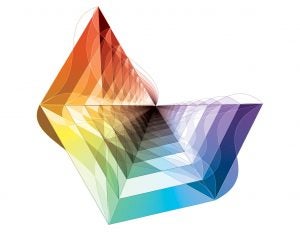Scattering amplitudes are fundamental objects in any quantum field theory. They describe probabilities of interactions of elementary particles. The standard method to calculate amplitudes is using Lagrangians and Feynman diagrams. This universal method suffers from huge redundancies when applied in gauge theories in gravity. In the modern powerful approaches like unitarity methods or recursion relations these redundancies are absent. In last few years there has been an increasing number of evidence that there exist a completely new formulation of physics using abstract mathematical objects. In the case of maximally supersymmetric Yang-Mills theory in planar limit it was showed that scattering amplitudes can be calculated of volumes of polytopes in abstract high dimensional spaces. The physical principles like unitarity and locality are derived from the underlying geometry. This discovery can shed new light on perturbation theory, and it might possibly lead to new more geometric reformulation of quantum field theory.
For a complete list of my papers see the INSPIRE link.
Recent discoveries
In 2012 we published a long paper on the relation between scattering amplitudes in planar N=4 SYM and positive Grassmannian. In this paper we defined new set of kinematical functions, on-shell diagra ms, and we showed that cuts of the amplitude as well as the recursion relations can be formulated in this language. The surprising part was the connection between these objects with the cells in the positive Grassmannian and permutations. In addition to being a fascinating connection it also proved that all singularities of amplitudes are logarithmic.
ms, and we showed that cuts of the amplitude as well as the recursion relations can be formulated in this language. The surprising part was the connection between these objects with the cells in the positive Grassmannian and permutations. In addition to being a fascinating connection it also proved that all singularities of amplitudes are logarithmic.
One year later, we found that this picture can be further generalized and the amplitudes can be calculated as volumes of Amplituhedron which is a generalization of the positive Grassmanian, not yet studied by mathematicians. This step removed rest of the physical intuition and defined the amplitude in abstract mathematical terms.
More recently, I have been working on the refinement of the amplituhedron picture for the logarithm of the amplitude (which exhibits a mild IR divergence) using negative geometry expansion which allows us to do all-loop order resummations. I have been also looking for non-planar generalizations of the Amplituhedron, this includes non-planar on-shell diagrams which might correspond to certain non-convex configurations in the Grassmannian.
I have been also very interested in the new formulations for gravity amplitudes. In particular, we found the Grassmannian formulation does extend for gravity on-shell diagrams, and more recently found some completely new formulas for certain tree-level amplitudes, and some unexpected relations between on-shell building blocks, which all point to some radically new formulation for gavity amplitudes yet to be discovered.
I also worked on the new methods how to calculate amplitudes in effective field theories. In particular, we showed that imposing soft limit behavior of scattering amplitudes fixes completely certain scalar effective field theories and we formulated new recursion relations in this context. We also applied this method to vector theories, and more recently found interesting connections to the double-copy and hidden zeroes.